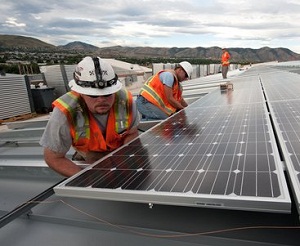Week in review: Solar takes its lumps, but isn’t done swinging
 With an industry still struggling to overcome some recent lumps last week wasn’t all so kind. Another solar photovoltaic company, Konarka, filed for bankruptcy and the industry even took some lumps from environmentalists, one of whom published a book that accused solar manufacturing of creating greenhouse gasses. Still, the world of solar didn’t just take the hits, it fought back. Numerous installations were completed and last week also saw some new big investments in solar, showing it has staying power. Just this morning Bank Of America announced a new $50 Billion fund to back solar, wind and other renewable energy projects as well as making loans to help individuals purchase hybrid vehicles.
With an industry still struggling to overcome some recent lumps last week wasn’t all so kind. Another solar photovoltaic company, Konarka, filed for bankruptcy and the industry even took some lumps from environmentalists, one of whom published a book that accused solar manufacturing of creating greenhouse gasses. Still, the world of solar didn’t just take the hits, it fought back. Numerous installations were completed and last week also saw some new big investments in solar, showing it has staying power. Just this morning Bank Of America announced a new $50 Billion fund to back solar, wind and other renewable energy projects as well as making loans to help individuals purchase hybrid vehicles.
The most pernicious hit to solar power last week came from the left, with the publication of Green Illusions, which throws solar under the bus in an attempt to call for simplification and reduction of energy use as the prime keys to keeping the world thriving in the face of climate change. As part of the argument, the book claims that the manufacturing of photovoltaics is one of the leading producers of rare but exceedingly harmful greenhouse gasses including hexafluoroethane (C2F6), nitrogen trifluoride (NF3), and sulfur hexafluoride (SF6). However, the book’s findings were quickly refuted by the National Renewable Energy Laboratory, which found that over the entire lifecycle of PV, on average the amount of greenhouse gases produced by a PV module equalled 45 grams per kilowatt hour. That’s compared to about 500 grams per kilowatt hour for natural gas and 1,001 grams per kilowatt hour for coal.
In another blow to solar, thin-film PV manufacturer Konarka filed for bankruptcy last week. The filing puts a smudge on Republican presidential candidate Mitt Romney, who has heavily criticized President Obama’s Administration for supporting Solyndra with federal funds. While Governor of Massachusetts Romney supported Konarka with state funds. But the company has had some significant detractors, among them Lux Research analyst Johnathan Melnik. Who said: “The underlying technology Konarka relied on was expensive, inefficient, and it didn’t last long enough.” Somewhat similar charges can be levied against Solyndra, although the most lasting charge against that company is that it could not reduce its manufacturing costs to match the fall in prices of silicon PV.
Even while some signs show the challenges facing solar manufacturers, others are still trying to get in the game and willing to place some large bets on solar manufacturing. For instance, a new ocmpany in Qatar, Qatar Solar Technologies is planning to open up a new photovoltaic manufacturing plant—and it just got $1 billion to do so. The company plans to build a PV manufacturing plant in Ras Laffan Industrial City. It’s receiving the fund from the $1 billion in single source financing from Qatari bank Masraf Al Rayan, Royal Bank of Scotland.
With the summer season officially on—almost—it’s about time to start seeing some more deals on solar, and they’re starting to show up. For instance, Sullivan Solar Power has now launched into its second phase of its three phase San Diego Solar Program. Under the program residents in San Diego county can now qualify for up to $1,500 in rebates from Sullivan. That’s in addition to rebates offered by the utility, state and federal government. The company hopes to install 3 megawatts of PV in San Diego County through the program. The current rebate will cover 1 megawatt of new residential installations in the county, after which, likely in August, the rebate level will fall.
Meanwhile legislation that would help Pennsylvania’s solar industry maintain its pace is facing opposition from the Pennsylvania Chamber of Commerce. The legislation, HB 1850 would expand Pennsylvania’s solar renewable energy credit (SREC) program. But the business organization contends it would Pennsylvanians and businesses $1 billion. The Pennsylvania Solar Energy Industries Association (PASEIA) contends that the legislation would add only a nominal cost to electric consumers in the commonwealth.



